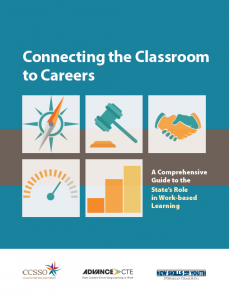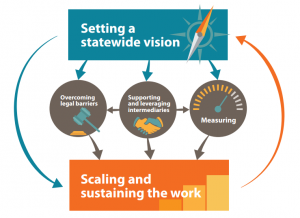Advance CTE’s “Research Round-Up” blog series features summaries of relevant research reports and studies to elevate evidence-backed Career Technical Educational (CTE) policies and practices and topics related to college and career readiness. This month’s blog elevates state examples of how federal funding might be used to administer youth apprenticeship. These findings align with Advance CTE’s vision for the future of CTE where each learner’s skills are counted, valued, and portable.
 Overview
Overview
In celebration of Apprenticeship Month, we’re elevating two reports from New America that provide state CTE leaders with helpful information about opportunities to leverage (or braid) funding to support youth apprenticeship or registered apprenticeship (RA) programs.
Background
Earlier this spring, New America published a blog, “Leveraging Existing Federal Funding Streams for Youth Apprenticeship,” in response to memos from the Office of Career, Technical and Adult Education (OCTAE), the U.S. Department of Education (DoE) and the U.S. Department of Labor (DoL) outlining how the Workforce Innovation and Opportunity Act (WIOA) and the Carl D. Perkins Career and Technical Education Act (Perkins V) can be applied in more flexible and innovative ways to support youth apprenticeship. New America then published a research study in early November on the challenges and opportunities facing community colleges that want to expand apprenticeship opportunities to their students. This report, “Community Colleges and Apprenticeship: The Promise, the Challenge” expands on key blog recommendations; notably, that state CTE leaders should consider using federal funds to partner with an experienced intermediary organization to build out RA programs statewide.
Apprenticeship Intermediaries
An apprenticeship intermediary is similar to “workforce intermediaries” in the public workforce system, which has a long history of facilitating connections between public and private services and workers. Unlike Registered Apprenticeship, which is well defined and regulated by the DOL, there is no definition of an “apprenticeship intermediary” in federal statute. In their study, New America utilizes the definition coined by the federal government, “An apprenticeship intermediary helps to build, launch, and run apprenticeship programs in collaboration with other apprenticeship partners. Just as many organizations may participate in apprenticeship partnerships—including employers, and often also labor organizations, secondary and postsecondary institutions, community-based organizations (CBOs), and industry organizations or associations—an equally wide array of organizations may perform intermediary functions.”
Intermediaries typically support program development and delivery; stakeholder engagement; monitoring, evaluation, and support services; and strategy and field building. These responsibilities make community colleges a strong contender to serve in this role as many of these services are already built into the institution.

Findings
This study found that community colleges are uniquely positioned to support the expansion of apprentices by acting as apprenticeship intermediaries”
- Community colleges successfully balance the needs of employers and apprentices because of their overlapping missions in training, workforce, and economic development as well as their experience serving diverse students.
- Nontraditional apprenticeships—like nursing and cybersecurity—can warrant a more active community college intermediary role because the occupations require academic credentials to get and keep a job.
- Community colleges acting as intermediaries can reduce the financial burden on students who want to train by tapping into a range of public funding options.
Recommendations
State and system policy plays a key role in supporting community colleges as apprenticeship intermediaries. State CTE leaders seeking to leverage community colleges to expand apprenticeship participation can:
- Create a last-dollar scholarship or tuition waiver policy.
- Integrate apprenticeship models into the funding formula.
- Adjust licensure requirements to remove prohibitive cost barriers.
- Brokering partnerships with universities to apply for DOL grants.
For further reading
Leveraging Existing Federal Funding Streams for Youth Apprenticeship also addresses the use of federal funds for teacher preparation programs.
Please visit Advance CTE’s Learning that Works Resource Center for additional resources about the benefits of expanding apprenticeships and strategies for leveraging community college partnerships.
- Supporting Community College Delivery of Apprenticeships
- State Funding Models to Support Youth Apprenticeships
- State Policy Playbook to Advance Youth Apprenticeship
Amy Hodge, Membership and Policy Associate


 In May, the Coalition for Career Development Center released the first annual
In May, the Coalition for Career Development Center released the first annual  For postsecondary CTE concentrators, the report finds that 40 states are placing 70 percent or more of secondary learners into postsecondary training and education, military or employment after high school graduation. Only three states, however, are placing 70 percent or more of all high school graduates into either a two-year or four-year postsecondary training or education program. The report recommends expanding post-school data points as well as counting military service and employment as post-school outcomes for learners.
For postsecondary CTE concentrators, the report finds that 40 states are placing 70 percent or more of secondary learners into postsecondary training and education, military or employment after high school graduation. Only three states, however, are placing 70 percent or more of all high school graduates into either a two-year or four-year postsecondary training or education program. The report recommends expanding post-school data points as well as counting military service and employment as post-school outcomes for learners.
 Once a statewide vision is in place and early implementation has begun, state policymakers should consider how to measure and scale work-based learning. There are two common approaches states take to building a comprehensive measurement and data-collection system: a systems-level approach that examines and evaluates the quality of the program, and a student-level approach that measures student learning and skill attainment. Through its
Once a statewide vision is in place and early implementation has begun, state policymakers should consider how to measure and scale work-based learning. There are two common approaches states take to building a comprehensive measurement and data-collection system: a systems-level approach that examines and evaluates the quality of the program, and a student-level approach that measures student learning and skill attainment. Through its